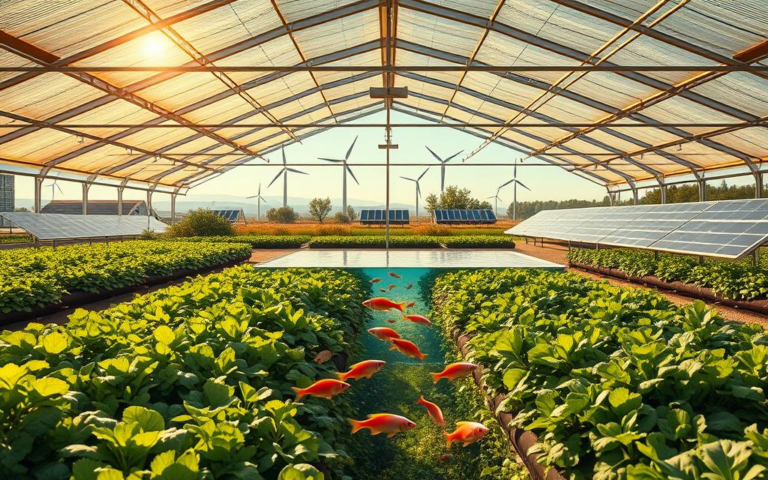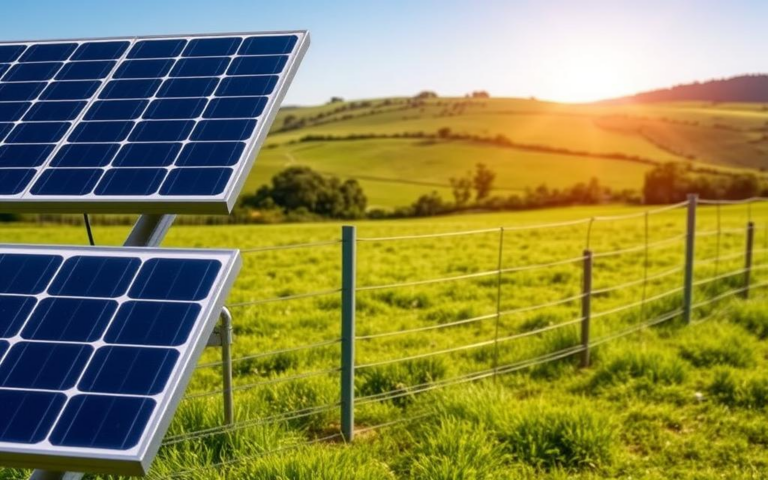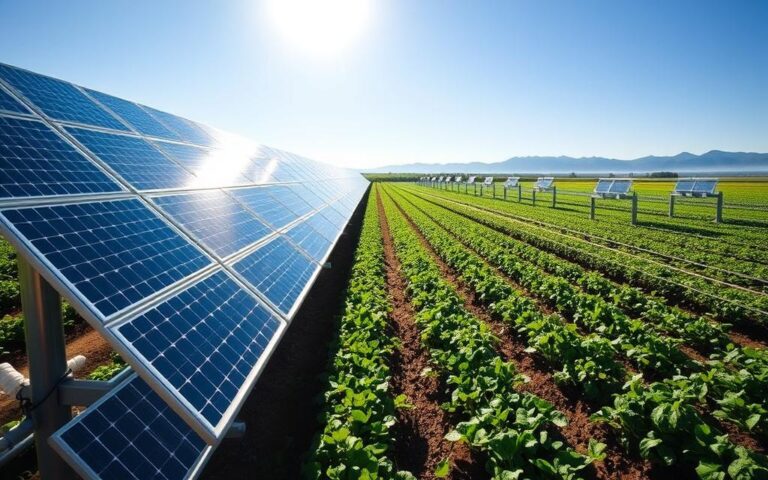U.S. farmers are finding new ways to manage their farms better. They’re using rainwater harvesting and solar pumps. These tools help save money and protect the environment.
Farming today needs fresh ideas using clean energy. Solar power and smart water systems give farmers new chances. They can improve their farms while using fewer resources.
Better water use is a big step forward in farming. Solar-powered pumps catch and move rainwater. This clean method helps farmers take care of animals more easily.
New energy tech helps farmers create smart water systems. These systems keep animals healthy and cut costs. They also help protect nature.
These clever setups are shaping the future of farming. They make work easier and greener for farmers everywhere.
Understanding Rainwater Harvesting Systems
Rainwater harvesting is a powerful water conservation strategy. It captures and stores rainwater for various uses. This approach reduces dependence on municipal water supplies and protects our precious natural resource.
Water conservation starts with understanding rainwater harvesting systems. These systems collect rainfall from surfaces like rooftops. They direct water through a carefully designed network of components.

Essential Components of Rainwater Collection
- Catchment area (roof or ground surface)
- Gutters and downspouts
- First flush diverter
- Filtration system
- Storage tanks
- Distribution mechanism
Rainwater Collection Methods
Several methods exist for collecting rainwater, each suited to different needs. These include roof catchment systems, ground catchment techniques, landscape contouring, and permeable pavement collection.
- Roof catchment systems: Most common residential method
- Ground catchment techniques
- Landscape contouring
- Permeable pavement collection
Proper design and maintenance are key to effective rainwater harvesting. Homeowners can reduce water bills by implementing these systems. They also contribute to broader water conservation efforts.
Solar Pump Technology: Harnessing the Sun’s Power
Solar pump technology revolutionizes water management in agricultural and rural settings. These off-grid solutions use sunlight to transform water distribution strategies. Farmers and landowners now have an eco-friendly alternative to traditional pumping systems.
Modern solar pumps turn solar energy into mechanical power through a smart process. This method maximizes renewable energy potential. The core parts work together to create an efficient water transportation system.
Core Mechanisms of Solar Water Pumps
Solar pump systems typically include several key elements:
- Photovoltaic solar panels
- DC-powered water pump
- Mounting structures
- Control systems
- Storage tanks or water reservoirs
Advantages of Solar-Powered Pumping Solutions
Solar pumps offer great benefits for agricultural water management:
- Zero electricity costs after initial installation
- Minimal maintenance requirements
- Reduced carbon footprint
- Reliable performance in remote locations
- Long-term cost savings
Farmers can improve water infrastructure by using these innovative solar pump technologies. This creates sustainable water management strategies. Such practices protect both economic and environmental interests.
Integrating Rainwater Harvesting with Solar Pumps
Green infrastructure is key in modern water management. Rainwater harvesting and solar pumps create a sustainable water security solution. This approach maximizes resources while reducing environmental impact and costs.
Integrating these technologies needs careful planning and design. Understanding key system considerations can unlock significant benefits for farmers and property owners.
System Design Considerations
- Evaluate total water requirements for specific applications
- Assess local climate and rainfall patterns
- Determine appropriate storage capacity
- Select compatible solar pump and harvesting equipment
Optimizing Water Flow and Pressure
Water security relies on efficient system design. The right setup ensures consistent water delivery through green infrastructure techniques.
| Design Parameter | Recommended Approach |
|---|---|
| Pump Capacity | Match output to water demand |
| Storage Tank Size | Calculate based on monthly water usage |
| Filtration System | Install multi-stage water purification |
Well-designed systems combine rainwater harvesting and solar pumps effectively. This approach supports both environmental and economic goals for property owners.
Benefits of Rainwater Harvesting Solar Pump Systems
Rainwater harvesting solar pump systems offer a groundbreaking approach to sustainable water management. These innovative solutions provide remarkable advantages for farmers and landowners. They also help with environmental conservation efforts and address water scarcity challenges.
Cost Savings and Return on Investment
Property owners can enjoy significant financial benefits from these systems. The initial investment quickly leads to long-term economic advantages.
These include reduced utility water expenses and minimal operational costs. Low maintenance requirements and potential tax incentives for sustainability also add to the benefits.
- Reduced utility water expenses
- Minimal operational costs
- Low maintenance requirements
- Potential tax incentives for environmental sustainability
“Investing in solar-powered water solutions is not just an environmental choice, but a smart financial strategy.” – Water Conservation Expert
Environmental Impact and Sustainability
Rainwater harvesting solar pump systems offer benefits beyond immediate water management. They contribute directly to climate resilience through various means.
These systems reduce carbon emissions and conserve natural water resources. They also minimize groundwater depletion and support ecosystem preservation.
- Reducing carbon emissions
- Conserving natural water resources
- Minimizing groundwater depletion
- Supporting ecosystem preservation
By using these sustainable technologies, people can make a real difference in environmental conservation. They can also secure reliable water resources for agricultural and personal use.
Designing an Efficient Rainwater Harvesting Solar Pump System
Planning a rainwater harvesting solar pump system requires careful thought. It’s key to understand your water needs and pick the right parts. This approach ensures an efficient and sustainable system.
A successful design involves several important steps. These steps help achieve the best performance and water management.
Calculating Water Requirements
Know your water needs before you start. This forms the basis of an effective system.
Consider these key factors:
- Household water consumption
- Agricultural irrigation demands
- Seasonal water usage variations
- Property size and landscape requirements
Selecting Essential Components
Choosing the right parts is crucial for a reliable system. Here’s what you need:
- Solar Panels: Choose high-efficiency panels matching your energy requirements
- Storage Tanks: Select appropriate capacity based on water needs
- Filtration Systems: Ensure water quality and cleanliness
- Pump Specifications: Match pump capacity to your water demands
“An efficiently designed rainwater harvesting solar pump system can reduce water costs by up to 40% while supporting sustainable living practices.”
Assess your needs carefully when designing your system. Choose the right parts to create a strong setup.
A well-planned system will meet your water management needs effectively. It can also help you live more sustainably.
Installation and Maintenance Best Practices
Rainwater harvesting solar pump systems need careful planning. These off-grid solutions are eco-friendly and can transform water management. They work well for agricultural and residential use.
Proper installation is crucial for system performance. Several factors can affect how well the system works. These include placement, materials, and following instructions.
DIY Installation Tips
Homeowners can install these systems themselves. Here are some important guidelines to follow:
- Conduct a thorough site assessment to determine optimal placement
- Ensure proper slope for water collection and drainage
- Select high-quality, durable materials resistant to environmental stress
- Follow manufacturer’s specifications precisely
- Use appropriate safety equipment during installation
“The key to successful DIY installation is meticulous planning and attention to detail.” – Renewable Energy Expert
Professional Installation Considerations
Professional installers bring special skills to off-grid solutions. They know how to integrate complex systems. These experts can make eco-friendly tech work at its best.
When choosing a professional installer, look for:
- Certified renewable energy technicians
- Proven experience with solar pump systems
- Comprehensive warranty offerings
- Detailed performance guarantees
Investing in professional installation can prevent costly mistakes and ensure long-term system reliability.
Case Studies: Successful Implementations
Rainwater harvesting solar pump systems have revolutionized water conservation efforts. These innovative solutions combine renewable energy with sustainable water management. Real-world examples show how these systems cut water use and provide efficient irrigation.
Small-Scale Garden Applications
Home gardeners are reaping the benefits of water-saving techniques with solar-powered irrigation. These projects have boosted water efficiency and plant health significantly.
- Typical garden water savings range from 30-50%
- Reduced municipal water dependency
- Lower energy costs for irrigation
Large-Scale Agricultural Projects
Farmers are turning to renewable energy to improve water management. These advanced systems are crucial for sustainable farming practices.
| Project Type | Water Savings | Energy Efficiency |
|---|---|---|
| Small Farm (50 acres) | 40-60% | 75% renewable energy use |
| Medium Farm (200 acres) | 55-75% | 85% renewable energy use |
| Large Agricultural Complex | 70-90% | 95% renewable energy use |
These case studies show the power of combining water conservation and renewable energy. Solar-powered rainwater harvesting systems offer sustainable solutions for various settings.
From small gardens to large farms, these systems tackle modern water management challenges. They provide efficient, eco-friendly options for irrigation and water conservation.
Overcoming Challenges and Limitations
Rainwater harvesting solar pump systems offer powerful solutions for water security. However, they come with unique challenges that require strategic planning. Understanding these obstacles helps develop robust water management strategies that enhance climate resilience.
Addressing Water Quality Concerns
Water quality is crucial for rainwater harvesting systems. Contaminants from roofs, pollution, and debris can compromise water safety.
- Install first-flush diverters to remove initial contaminated water
- Use multi-stage filtration systems
- Implement regular water testing protocols
- Consider UV sterilization for additional purification
“Clean water is not just a necessity, but a fundamental right in sustainable water management.” – Water Research Foundation
Dealing with Seasonal Variations
Climate resilience requires adaptable water collection strategies. These must account for seasonal changes in rainfall and sunlight.
| Season | Water Collection Strategy | Recommended Action |
|---|---|---|
| Dry Season | Limited Rainfall | Maximize storage capacity |
| Rainy Season | High Precipitation | Optimize collection infrastructure |
| Winter | Potential Freezing | Implement frost protection mechanisms |
Addressing water quality and seasonal challenges is vital. This approach ensures rainwater harvesting solar pump systems provide reliable, sustainable water solutions. As a result, these systems can significantly strengthen local water security.
Government Incentives and Rebates
Green infrastructure investments like rainwater harvesting solar pump systems can be financially attractive. Government incentives aim to encourage environmental sustainability and support innovative water management technologies.
Understanding federal and state programs can significantly reduce your initial investment costs. These programs offer various ways to make green projects more affordable.
Federal Funding Opportunities
The U.S. government offers several incentives for sustainable water technologies. These include REAP grants, EPA water infrastructure funding, and DOE renewable energy incentives.
- Rural Energy for America Program (REAP) grants
- Environmental Protection Agency (EPA) water infrastructure funding
- Department of Energy renewable energy incentives
Tax Credits and Financial Benefits
Homeowners and businesses can get tax credits for green infrastructure solutions. These credits can greatly reduce the cost of implementing sustainable systems.
| Incentive Type | Potential Savings | Eligibility |
|---|---|---|
| Renewable Energy Tax Credit | Up to 30% of system costs | Residential and commercial properties |
| State-Level Rebates | Varies by state | Location-specific programs |
| USDA Conservation Grants | Up to $20,000 | Agricultural projects |
These incentives can help property owners overcome financial barriers to sustainable water management. By using these programs, you can save money and support environmental conservation efforts.
“Investing in green technology today creates a more sustainable tomorrow” – EPA Sustainable Water Infrastructure Initiative
Research local and federal programs to maximize your financial benefits. This approach can help you support environmental goals and save money on your green projects.

Future Trends in Rainwater Harvesting and Solar Pump Technology
Eco-friendly technologies are evolving rapidly, changing water management and renewable energy solutions. Innovations in rainwater harvesting and solar pump tech are advancing sustainable water systems. These developments benefit both agricultural and residential applications.
New technologies are revolutionizing water capture, storage, and use. They’re making renewable energy systems more efficient and accessible. These innovations are also adding intelligence to water management.
Emerging Technologies and Innovations
Exciting breakthroughs are shaping water management’s future. These include advanced nano-filtration for efficient water purification and high-performance solar panels with better energy conversion.
Machine learning algorithms now optimize water usage predictively. New lightweight, durable materials are improving solar pump components.
Integration with Smart Irrigation Systems
Digital intelligence is creating new opportunities in water management. Smart irrigation systems use real-time data to improve efficiency. They monitor soil moisture and adjust water distribution automatically.
These systems can predict water needs based on weather patterns. They also use precision technology to minimize water waste.
As renewable energy solutions advance, expect more intuitive water management systems. These will reduce environmental impact and improve resource use. Farmers and homeowners will benefit from these energy-efficient innovations.
Getting Started: Steps to Implement Your Own System
Begin by assessing your property thoroughly. Understand your water needs and landscape features. This knowledge is vital for designing an effective sustainable water solution.
Transform your water management approach by evaluating your unique resource requirements. Consider factors like rainfall patterns, soil type, and available space.
Choosing the right professionals is crucial for success. Research local experts in renewable energy and water conservation. Look for certified installers with experience in solar pump systems.
Check their credentials and review past projects. Request detailed consultations to ensure they meet your specific goals.
Budget planning is key when considering this system. Get quotes from reputable suppliers and compare equipment specs. Look into installation costs and potential long-term savings.
Many regions offer incentives for sustainable water management. These can help offset your initial investment costs.
Start your journey with informed decisions. Assess your property and partner with qualified professionals. Understand the environmental and financial benefits of this system.
Create a robust water collection system that meets your needs. Support broader ecological conservation efforts with your sustainable choice.
FAQ
What exactly is a rainwater harvesting solar pump system?
This system combines water collection and solar-powered distribution. It captures rainwater from roofs, stores it in tanks, and uses solar pumps for irrigation. This eco-friendly solution conserves water and reduces energy costs using renewable solar energy.
How much can I potentially save by installing a rainwater harvesting solar pump system?
You could save 30-50% on water bills and eliminate electricity costs for pumping. The initial investment typically pays off within 3-5 years through reduced utility expenses.
Are these systems suitable for both residential and agricultural use?
Yes! These systems are versatile, from small home gardens to large-scale farms. They can be scaled to meet specific water management needs.
What maintenance is required for a rainwater harvesting solar pump system?
Regular maintenance is simple and includes cleaning solar panels and checking water filters. It also involves inspecting storage tanks for debris and ensuring pump connections are secure.
Most systems need minimal annual maintenance, typically just a few hours of check-ups.
Can these systems work in areas with limited sunlight?
Modern solar pump technologies are efficient and can generate electricity in low-light conditions. Systems can be designed with extra solar panels or battery storage for less sunny regions.
What government incentives are available for installing these systems?
Many states offer tax credits, grants, and rebates for renewable energy and water conservation technologies. Federal programs like the Investment Tax Credit can offset 26-30% of installation costs.
Check with local and state authorities for specific programs in your area.
How environmentally friendly are these systems?
These systems are extremely eco-friendly. They reduce reliance on municipal water and minimize carbon emissions. They also decrease groundwater extraction and support sustainable water management practices.
What is the typical lifespan of a rainwater harvesting solar pump system?
With proper maintenance, these systems can last 20-25 years. Solar panels typically have 25-30 year warranties. Pumps can last 10-15 years, and storage tanks can endure 15-20 years.
Regular maintenance and quality components are key to maximizing the system’s longevity and performance.



